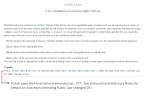
6. Conference Report
H.Rpt, H.Conf.Rpt=House Conference Report (may be same as for House Report)
S.Rpt=Senate Conference Report (same as for Senate Report)
example: H.Rpt 111-89
7. Presidential Signing Statement
WCPD=Weekly Compilation of Presidential Documents
DCPD=Daily Compilation of Presidential Documents
See Bluebook Rule 13 for citing rules.
Click on links to see examples of each document.
A bill (H.R. or S.) is introduced in the House or Senate. Analyzing versions of bills can sometimes help explain Congress' intent.
The bill is referred to the appropriate Subcommittee. That subcommittee may hold Hearings (H.Hrg or S.Hrg) (where interested parties for and against express their opinions on the bill).
If the bill is approved by the Committee (or Subcommittee), the Committee issues a Committee Report (H.Rpt or S.Rpt). This is usually the best source for legislative intent, as it has a section-by-section analysis.
If the first chamber passes the bill, the bill then goes to the other chamber and goes through steps 1-4 again. The other chamber may also introduce its own version independently.
Once the measure goes through both the House and Senate and passes in both chambers, if there are any differences, there will be a Conference Committee which may produce a Conference Report (H.Rpt, H Conf.Rpt. or less frequently S.Rpt).
If the House and Senate agree upon a version, the bill then goes to the President for his signature. The president may issue a statement with his signature, known as a Presidential Signing Statement (WCPD or DCPD).
To use many legislative history sources, you need to know the Public Law Number.
To find the Public Law (P.L.) number:
